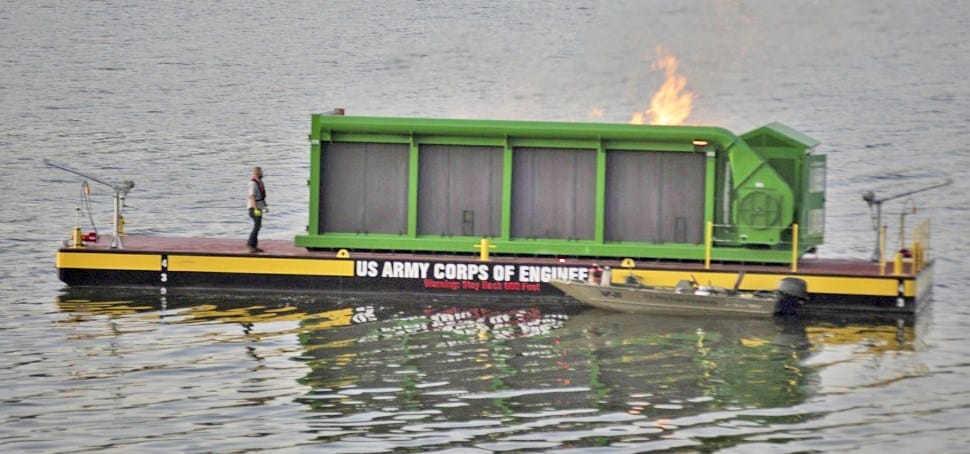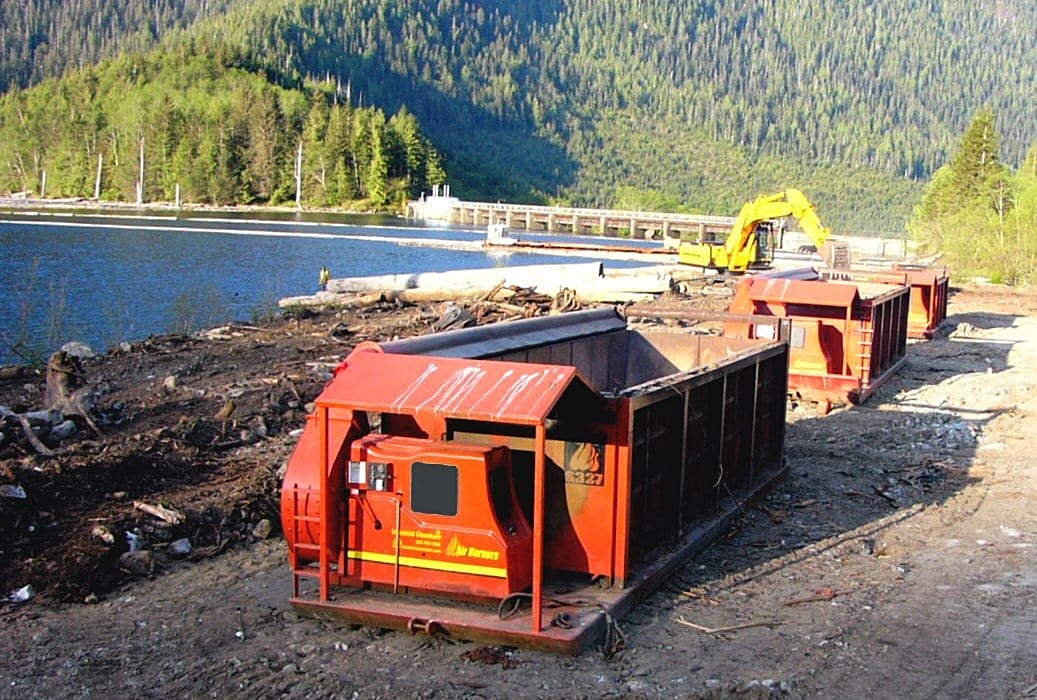Air Curtain FireBoxes: The Perfect Tool for Woody Waterborne Debris Elimination
Hazardous Debris removal from waterways and shorelines poses an unusual challenge because accessibility is usually burdensome and special techniques may be required. First, the emphasis lies on hazardous debris that is waterborne, either floating or submerged or deposited on shore-lines.

The distinction between hazardous and beneficial (coarse) water-borne debris (Photo above) must be made because wood that has fallen into streams, rivers, ponds, and lakes plays an important role in maintaining a healthy ecosystem for fish and other marine life including marine plants. Here we are addressing only woody waterborne and shoreline de-bris that is a hazard to navigation, poses a wildfire risk, or is otherwise a detriment to recreational activities or commercial body of water utilization, such as reservoirs of hydropower plants, harbors, marinas, and shipping canals.
Hazardous or unwanted woody water-borne or shoreline debris accumulates mostly from trees and tree branches washed onto the banks of rivers, canals, and lakes or into the waterways from storm events, like tornadoes, ice storms, or hurricanes (Photo below).

Some debris originates from illegal dumping of wood waste. Floating trees in hydro dam reservoirs are trees that were standing in a valley before it was dammed up and flooded. Over time these tree trunks are released from the bottom of the reservoir and they float to the top where they can be a menace as they collect at the turbine intakes.
The collection and disposal challenge for these various scenarios is the same: there are hardly ever any suitable access roads to processing areas and most of the time there is not even any room on shorelines. Traditional disposal schemes, like open pile burning and chipping with hauling to remote disposal sites, are impractical and costly, if not impossible. Moreover, the large Diesel engines used for this scheme release significant amounts of Greenhouse Gases. They are often unsuitable due to wildfire danger and smoke pollution at or near recreational and residential lake or riverfront locations. The single wide-open area is the waterway itself, and an air curtain FireBox on a floating barge makes perfect sense (Photo below).

Whether on the ground or on a barge, the FireBox by Air Burners is the most suitable machine to eliminate massive amounts of woody debris quickly and in an environmentally sound way. This has been tested for decades and is practiced around the world.


A barge floating on the waterway offers the perfect mobility for the air burner (Photos above) It can be anchored close to the debris collection spots on the shore from where the debris is taken to the air curtain burner by a small feeder barge with a loader. The same collection barge fetches waterborne debris out of the water, gathers it on the barge, and when full, takes it to the burner for disposal. There is no need for the wood debris to dry out first, it can be burned wet as it is removed from the water. That is not possible for alternate material processing methods, like chipping or even open pile burning. The FireBox residuals are carbon ash and some biochar which would be applied to woodlands that line the lake or river banks.


Hydro dam reservoirs require ongoing waterborne debris removal for many years (Photos above). Building a landing at the edge of the reservoir near the dam is also practiced. The unrooted trees tend to float with the current towards the dam. They are corralled by vessels and moved to the landing where they are taken from the water straight into the FireBox, if they fit or cut to size then burned.
For disaster recovery cleanup at canals with commercial shipping lanes, FireBoxes are employed on the canal banks and dragged from debris pile to debris pile as far as the shoreline allows. Again, wet debris can be accommodated.
To learn more about the waste management and waste-to-energy technologies developed by Air Burners, logon to www.airburners.com.
USACE “Pride of the Cumberland” S327 Video on YouTube: https://youtu.be/WKk_QxM41I4
“Pride of the Cumberland”: Feeder & Loading Barge (left) and Debris Eliminating FireBox Barge
Feeder Barge (left) taking Wood Waste to FireBox
Hydro Dam Reservoir Waterborne Debris Elimination by multiple S327 Air Curtain Burners
